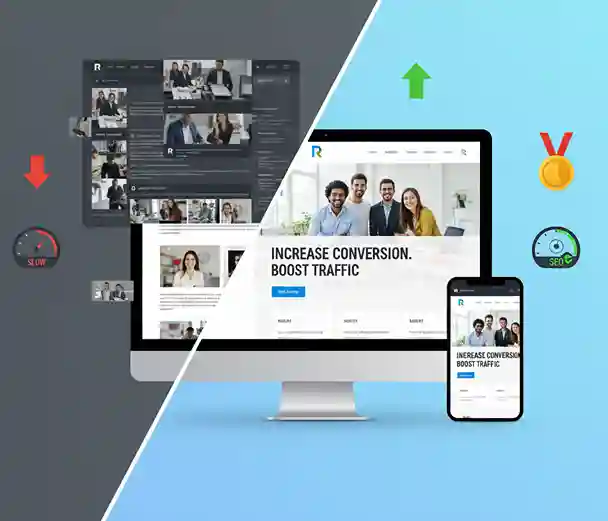

2025-10-03
Website design audit and redesign: How to double conversion without losing SEO rankings
Design audit & redesign: Boost your website conversion
Tags:
Your website is your primary online salesperson, working 24/7. But how effective is it? If your conversion rate is dropping and traffic isn't growing, the problem likely lies in an outdated or inefficient design. A website design audit and a smart site redesign are not just cosmetic fixes; they are strategic investments that can significantly boost your sales.
When Should You Conduct a Design Audit and Plan a Redesign?
Redesigning is a major project that requires resources. However, there are clear signals that it's time to act:
- Low Conversion and High Bounce Rate. Users are visiting the site but aren't completing goal actions (purchase, order, subscription).
- Outdated Aesthetics. The design looks like it's from 2010. This erodes trust in your brand.
- Poor Mobile Adaptability. Over 60% of web traffic comes from mobile devices. If your site displays incorrectly on a smartphone, you're losing customers and Google rankings (due to Mobile-First Indexing).
- Complex Navigation (Usability). Users cannot quickly find the necessary information or the order button.
- Brand Change or New Services/Products. The website must reflect the company's current strategy.
Stage 1: Comprehensive Website Design Audit (Diagnosis)
Before drawing up new mockups, you need to understand what's working and what isn't. A professional website design audit includes several critical checks:
1. Usability Audit (UX/UI)
This is a check of convenience and usage logic. The goal is to ensure an easy user path to the target action.
- Navigation: Is the menu clear? Are there breadcrumbs? Does the user need more than three clicks to reach a goal?
- CTA Clarity (Calls to Action): Are buttons visible, and is it clear what they do?
- Responsiveness: Mandatory check for display across all devices (smartphones, tablets, desktops).
- Visual Hierarchy: Are blocks logically positioned, and are key benefits highlighted?
2. Technical SEO Audit
This is the foundational check, without which any website improvement will be pointless. An SEO audit must be the first step of a redesign.
- Loading Speed: A slow site means a high bounce rate and poor ranking. Analyze Core Web Vitals (Google PageSpeed Insights).
- Indexing and Crawling: Are there errors in the
robots.txtandsitemap.xmlfiles? Are all important pages indexed? - Metadata and Headings: Are the Title, Description, and H1-H6 headings correctly implemented?
3. Content Audit
Assessment of content quality and relevance. Do the texts match user search queries? Are there duplicates? Is the information current?
Stage 2: Proper Website Redesign with a Focus on SEO
A site redesign is your chance not only to update the visuals but also to improve your SEO foundation. The main rule: never start a redesign without an SEO strategy.
1. Planning New Structure and Navigation
The new design must be optimized for your existing semantic core. If you are changing URLs, immediately compile a map of 301 redirects. This is critically important to preserve your current SEO rankings and traffic.
2. Design That Sells (UX/UI)
Create a visually appealing and user-friendly design. Focus on:
- Clean, Modern Style: Minimum visual noise, maximum attention to target information.
- Mobile Version: The design should be developed mobile-first.
- Improving Form Usability: Make the ordering process as simple and fast as possible.
3. Technical Optimization During Development
During the implementation of the new design, developers should:
- Optimize Images: Compression, use of WebP formats, correct
altattributes. - Minimize Code: Removing unnecessary scripts, optimizing CSS/JS for maximum loading speed.
- Implement Schema Markup: Adding structured data helps search engines better understand the content and can improve the appearance of search snippets.
A website design audit is the first and most crucial step toward a healthy, high-converting resource. A comprehensive approach that combines SEO audit, usability analysis, and a strategic site redesign
Don't risk your rankings—entrust your website improvement to experts who guarantee the preservation of SEO metrics during any design changes!
Last News.






_11zon_11zon.webp)